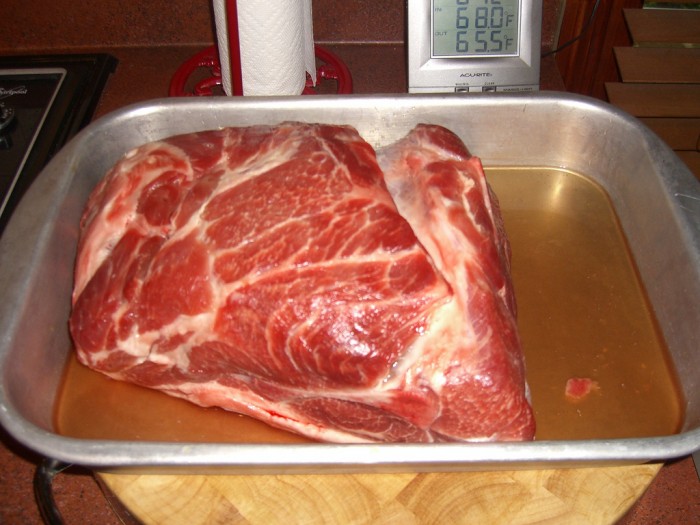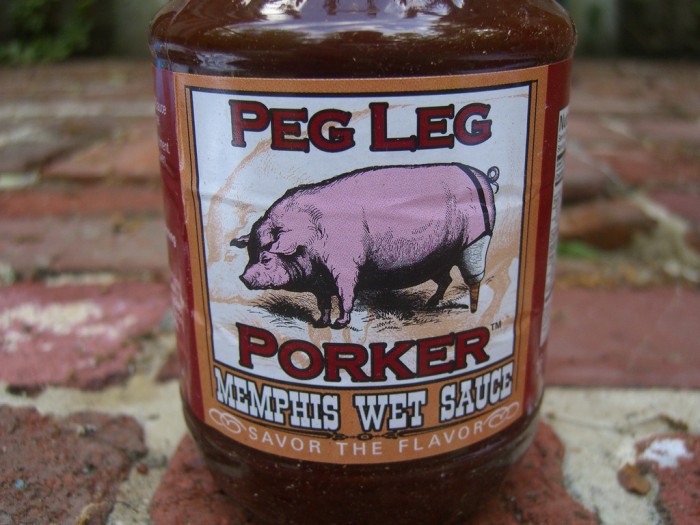
I’ve loved pork for a long time – waaay before the hipsters made bacon worship popular. One of my favorite ways to spend a Saturday afternoon is to put a pork butt on the smoker first thing in the morning and watch college football all day while the meat soaks up the hickory goodness. Since you have to add new wood every hour or so, it pretty much guarantees that you have to stay on your couch all day and restoke the fire at halftime of each game. Sorry about those chores, sweetie. Can’t you see I’m working here?
While there are probably lots of places in your town to pick up a pound of your bbq, occasionally it’s nice to be able to show off your grillsmanship and smoke your own butt or shoulder. Luckily, there is The Peg Leg Porker himself, Carey Bringle, is here to help you out.
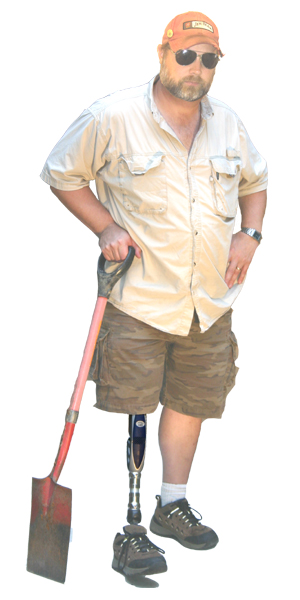 If you’ve ever had the chance to meet Carey, you’d discover that he’s one of the bbq circuit’s true characters. He’s the kind of guy whose business card reads: “Wars Fought — Stud Service — Revolutions Started — Tigers Tamed — Assassinations Plotted — Bars Emptied — Governments Run — Uprisings Quelled — Orgies Organized.” Depending on when you ask him, he will tell you that he lost his leg to a shark attack or in a bar fight or that he donated it to an Olympic marathoner that needed a spare tire. The truth is more mundane, but Carey’s attitude is always optimistic and contagious. The delicious irony of this old joke only makes it better. Plus, it fits in perfectly with the logo on his barbecue sauce.
If you’ve ever had the chance to meet Carey, you’d discover that he’s one of the bbq circuit’s true characters. He’s the kind of guy whose business card reads: “Wars Fought — Stud Service — Revolutions Started — Tigers Tamed — Assassinations Plotted — Bars Emptied — Governments Run — Uprisings Quelled — Orgies Organized.” Depending on when you ask him, he will tell you that he lost his leg to a shark attack or in a bar fight or that he donated it to an Olympic marathoner that needed a spare tire. The truth is more mundane, but Carey’s attitude is always optimistic and contagious. The delicious irony of this old joke only makes it better. Plus, it fits in perfectly with the logo on his barbecue sauce.
A competition cooker, Carey is a three-time medalist in the Memphis in May World BBQ Competition and Bon Appétit magazine named his sauce as one of their top five favorites. Rather than keep his proprietary recipes and secrets to himself, Carey has assembled a kit of tools and ingredients to allow you to make your own pulled pork or poultry on your gas or charcoal grill or your home smoker. He sells them on the QVC network or you can get one at his website for $39.99 including free shipping.
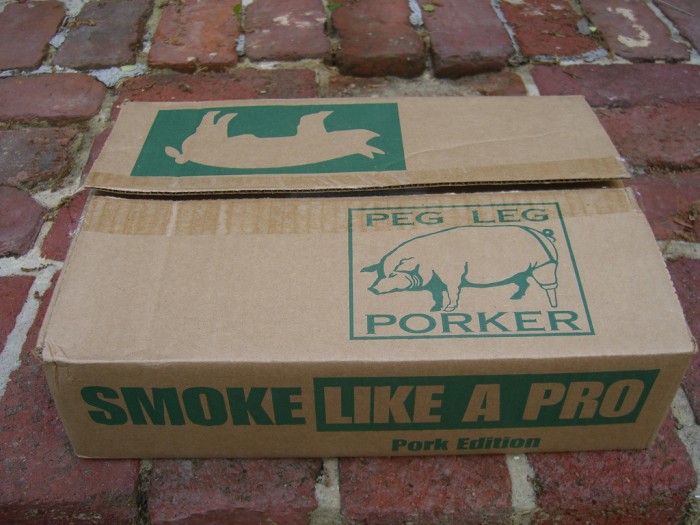
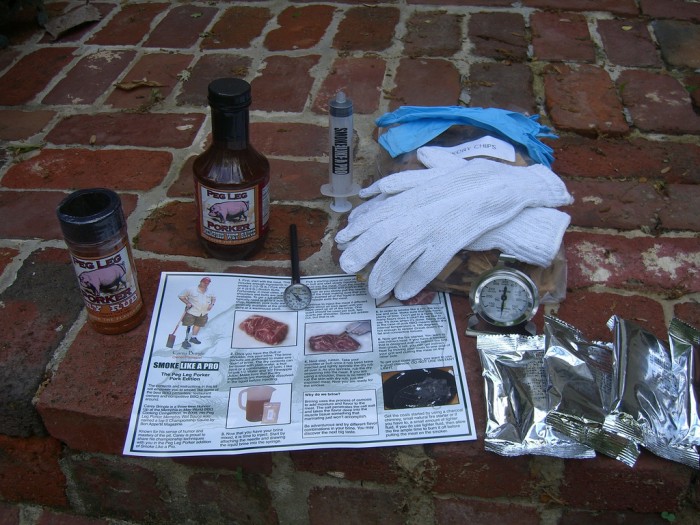 The box contains:
The box contains:
5.5 oz. bottle dry seasoning
16 oz. bottle Memphis Wet Sauce
4 packets brine mixture
1 oz. Injection syringe and needle
Stainless-steel grill thermometer
Stainless-steel pocket thermometer
1 bag wood chips?1 pair cotton prep gloves
1 pair non-latex gloves
Step-by-step instruction card
That last thing is the most important part. You could probably buy most of the other tools at your local Home Depot for a little less money, but the detailed simple instructions that Carey includes are priceless. Follow his advice and you can’t go wrong.
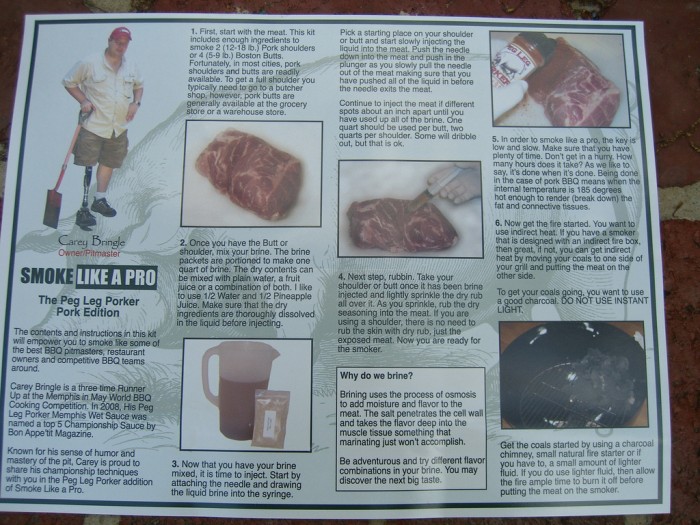
Carey emphasizes that you have to brine your meat before you try to smoke it. Brining adds flavor and moisture to the meat through osmosis that allows salt to actually penetrate at the cellular level. All you have to do is add his brine mix to water and pineapple juice and inject it throughout the shoulder or butt with the provided syringe. I let the brine work overnight to ensure that the effect was maximized.
After patting the pork (snicker) dry, liberally sprinkle the dry rub all over the butt or shoulder. This crust will eventually caramelize into the dark bark that gives your pulled pork the delightful crunchy bits that complement the wonderful smoky flavor provided on the grill. 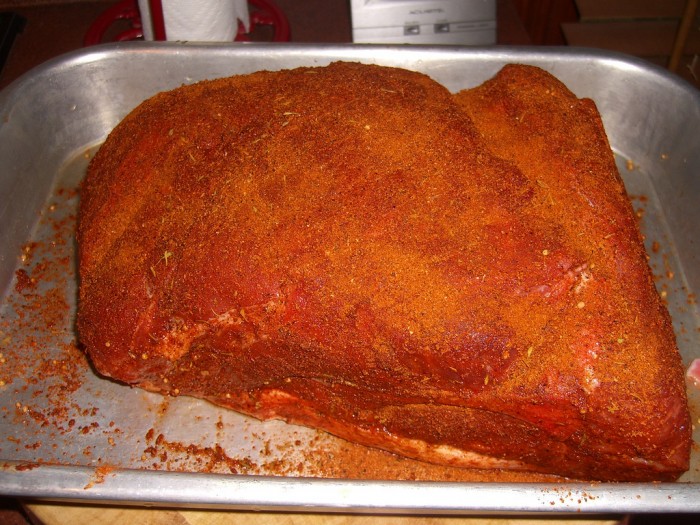
 The entire goal of smoking pork is to get the internal temperature up to the 185-190 degree range as slowly as possible. At that temperature, the internal collagens and fats break down to the point where the individual fibers of the meat can be pulled apart in the pig picking process. The slower you can achieve this, the more time there is for the delicious fats to render themselves and contribute their flavor to the meat. If you cook it too quickly, you’ll just end up with an overcooked pork roast. That can be tasty, but it ain’t barbecue.
The entire goal of smoking pork is to get the internal temperature up to the 185-190 degree range as slowly as possible. At that temperature, the internal collagens and fats break down to the point where the individual fibers of the meat can be pulled apart in the pig picking process. The slower you can achieve this, the more time there is for the delicious fats to render themselves and contribute their flavor to the meat. If you cook it too quickly, you’ll just end up with an overcooked pork roast. That can be tasty, but it ain’t barbecue.
Whether you use a grill or an electric smoker like I did, the key is to keep the fire consistent and the cooking temperature between 200 and 220 degrees. The electric smoker is very good at this, but you must constantly add hickory chips to the heating element to keep the smoke flowing around the meat.
On a grill, this is accomplished though indirect cooking. Build your fire on one end of the grill and cook the shoulder on the other end. If you have vents that you can open over the meat and close over the fire, that helps to keep the fire low and draws the smoke across the pork to help create that beautiful purple ring of smokiness that separates good barbecue from mediocre. Pile your presoaked hickory chips directly on the burner or fire with a special emphasis on applying as much smoke as possible during the first few hours of the cooking process. There is a school of thinking that after the meat begins to reach higher temperatures that it becomes less receptive of the smoke, so smoke ’em while you got ’em.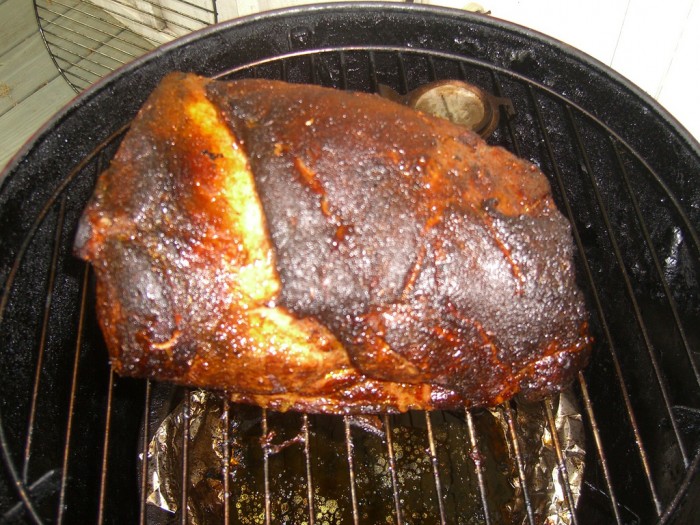
How long should this process take? Since the key is cooking low and slow, the answer is that it’ll be done when it’s done. You should minimize the amount of times you open the smoker to add chips because that lets smoke out and reduces your cooking temperature. As Carey advises, “Lookin’ ain’t cookin’.” To prevent the meat from drying out, you might want to mop your meat (snicker) with a solution of apple cider vinegar, water and apple juice. I try to time my mopping to once an hour when I add hickory chips to reduce the number of times I have to disturb the cooking environment. Don’t plan on starting in the morning and eating your pork for dinner, since this whole ritual can take over twelve hours.
After the butt or shoulder has been on for at least ten hours, it’s time to start checking internal temperature. You can use a probe thermometer that you leave in the meat or I prefer to check with my handy dandy Thermapen. By this point, the bark should be almost black. Don’t worry; you didn’t burn the ‘cue. You’ve just cocooned it in a crust of awesomeness. When the internal temperature reaches about 190 degrees, it’s time to take it off.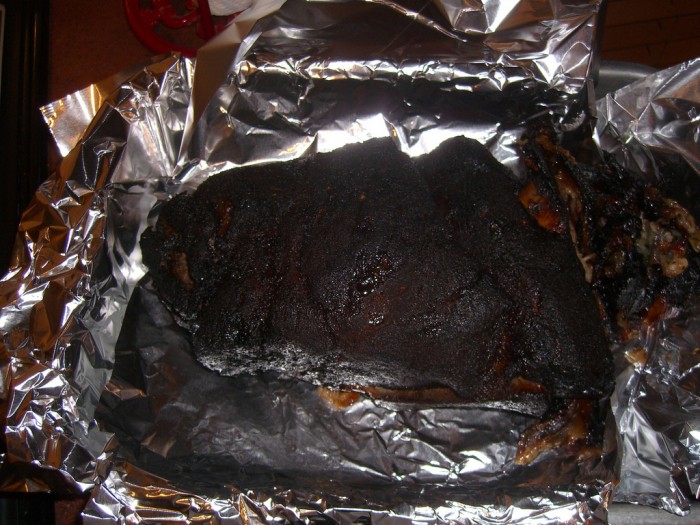
Wrap it in foil and let it rest on the counter for at least an hour so that the juices can be retained and the pork cools enough to allow for easy pulling. The internal shoulder plate bone should pull right out of the shoulder or butt and then it’s officially pig pickin’ time. I recommend wearing vinyl gloves to protect you from the heat and messiness. This is a great family activity, but only if you can monitor the “sampling” that inevitably happens during the process. Otherwise, you may find yourself without enough meat left to put on a biscuit. I like to use two large forks with the tines turned out to separate the meat without shredding it.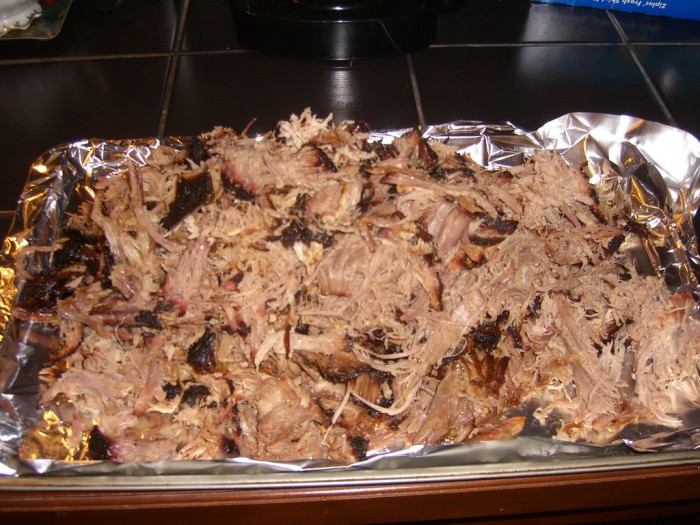
With or without wet sauce, your pork should be delicious. The last time I smoked a shoulder to Carey’s specifications I ended up with more than 5 pounds of barbecue for an investment of less than $20 and a lazy day of work. Reviews from friends included phrases as “Ohmifreakin’ Gawd!” and “This is the best damn BBQ I’ve ever eaten.” I don’t think it’s the best shoulder sandwich I ever ate, but I will accept the praise. And give the credit to The Peg Leg Porker. Check it out and become a pro yourself, or give one as a holiday present to somebody you love who might invite you over for some prime pork!
Smoke Like a Pro BBQ Kit available at The Pegleg Porker Website
MSRP: $39.99
What I Like: Clear step-by-step instructions written in a very conversational voice. Kit contains everything you need to make great Memphis-style bbq.
What Needs Improvement: Not a danged thing. This product really does make me look like a pro.

